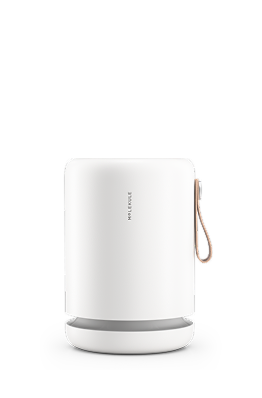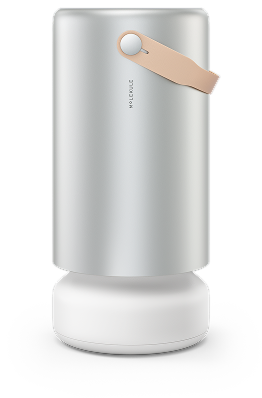Individual viruses are very tiny, usually on the order of .025 to .2 microns. A human hair is about 80 microns wide, thousands of times bigger than a single virus. Even though they are very small, just one virus-carrying particle could be capable of infection. Experiments at two laboratories measured how well Molekule Air Mini could capture and destroy these tiny potent pathogens.
This research was necessary because Molekule purifiers come with patented PECO technology, which uses photocatalytic technology to physically destroy airborne organic pollutants like VOCs, bacteria, mold, and viruses. PECO technology is a new method of cleaning the air, and as a result requires rigorous research to prove its effectiveness. To test the microbe-destroying power of the smallest member of Molekule’s air purifier family, Molekule Air Mini, two different labs undertook experiments to investigate how effectively the device could remove virus particles from the air.
Not satisfied with just showing capture rate, the two labs also undertook experiments to further test the abilities of the purifier. Aerosol Research and Engineering Laboratories tested Air Mini’s efficiency in removing small aerosolized particles from the air to characterize how the device might work on capturing the droplets that carry infectious viruses. At Intertek, the researchers analyzed a filter that had been used to remove viruses and tried to find viable examples remaining in the filter. In all cases Air Mini performed well.
Molekule Air Mini at ARE Labs
The researchers at Aerosol Research and Engineering Labs designed two experiments for Air Mini. The first was to measure the particle capture of particles the same size as viruses, then the second to measure capture of actual live viruses. They performed the experiments in their Bioaerosol Test Chamber, pictured below, which is about 9x9x7 feet, the size of a small bedroom.

Using a chamber like this is vital for this type of research. It allows the researchers to control the environment and prevent any unwanted contaminants from ruining their measurements. The chamber is equipped with ports to introduce the pollutants and to collect samples of the interior air as it is purified by Air Mini.
The researchers used an aerodynamic particle sampler to measure the sizes of particles in the chamber. They looked for the presence of viruses using standard plating and enumeration techniques to gauge the total concentration in the air.
First, Molekule Air Mini removes droplet-sized particles
Viruses exhaled by infected people float through the air in aggregated droplets that are predominantly 1 micron in width, but could be as larger or smaller. For the first experiment, tiny plastic beads ranging in size from 0.5 microns to 5 microns were sprayed into the chamber to simulate virus-carrying droplets of similar size. The researchers conducted this test both with the purifier activated and deactivated and compared how quickly the particles were removed. The results for three representative particle sizes are shown in the graph below. The flat colored lines across the top represent natural settling of the particles. The steep colored lines to the right represent the effect of the purifier.

Please note the y-axis (reduction percentage) on this graph is logarithmic. For example, Air Mini reduced 90% of the particles in about 15 minutes and 99% of the particles in 30 minutes. At around 1 hour with Air Mini in operation, 99.99% of the particles were gone and the aerodynamic particle sampler could not detect their presence at all.
Then, Molekule Air Mini removes actual viruses
After establishing this basic characterization of Air Mini’s filtration efficiency, the team moved on to actual viruses. They selected the MS2 bacteriophage which is a common proxy virus for infectious diseases. It is a virus that is biologically very similar to those that cause human disease such as influenza or measles, but only infects bacteria so is much safer to work with than the actual influenza or measles virus. Individual particles of MS2 bacteriophage are about .027 microns in diameter. Influenza, by comparison, is typically about .1 micron in diameter, but in real-world circumstances airborne viruses travel in aggregated droplets of larger sizes. MS2 bacteriophage is commonly used in airborne virus research to compare alongside infectious diseases.
The research team sprayed the MS2 bacteriophage into the chamber many times. Each time they took air samples every thirty minutes for two hours, then fully purged the air in the chamber for the next run. This chart represents the findings. The blue line across the top is the control, the viral concentration without the purifier running. The other lines are different trials with the purifier running.

As in the chart before, the y-axis of this chart is logarithmic, so -1.00 is 90% reduction, -2.00 is 99% reduction and so on. For example, in the first 30 minutes Air Mini reduced viral concentration about 99.2%. In the control, viruses were reduced in the same time period by 53.2%.
Overall the testing at ARE provides some good evidence on exactly how effective Air Mini can be when challenged to remove viruses from the air.
You can read the whole of the report with all of the details here.
Molekule Air Mini at Intertek
Intertek operates a series of world-renowned labs known for their accurate and reliable product testing. In order to investigate Molekule Air Mini’s virus destruction efficiency, the research team at Intertek’s biological testing facility looked not only at Air Mini’s ability to capture airborne viruses, but also what happens to those viruses after they land on the filter.
Molekule Air Mini destroys the viruses its removes from the air
The safe surrogate for infectious viruses used in these experiments is called Phi-X 174. This virus is also only known to infect bacteria and is thus very safe for the researchers to work with. Phi-X 174 is about 35 nanometers in diameter, and when aerosolized, travels in droplets like other viruses. Its genome has been very well categorized by science.
The Intertek researchers placed Air Mini in their 10x10x10′ biological testing chamber, sprayed in the virus, and collected samples every 15 minutes for 2 hours. After this, they allowed the device to run for 24 hours. Then they cut out a piece of the filter and tested it for viruses.
When collecting airborne viruses, Air Mini was able to reduce the concentration by 98.7%. When the researchers looked for live viruses on the filter, they could not find a single one, confirming they were destroyed after capture.
Read the whole report here.
Laboratory testing is important
It is not just important to select the correct organisms and have a testing chamber that is properly sealed, these techniques are part of the larger body of scientific discipline for air quality research. The methods used by labs like Intertek and Aerosol Research and Engineering are informed by consensus standards established by international bodies and scientists. Merely using tools at home to test the efficacy of a product can lead to some interesting findings, but only laboratory data will tell the whole story.
Be sure the products that you trust are backed up by solid laboratory science. Read more about the performance data that Molekule makes available on our papers page.







